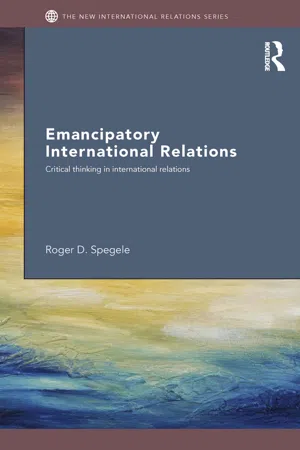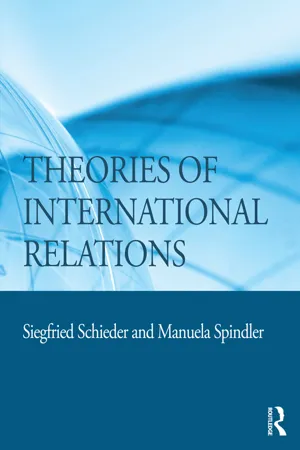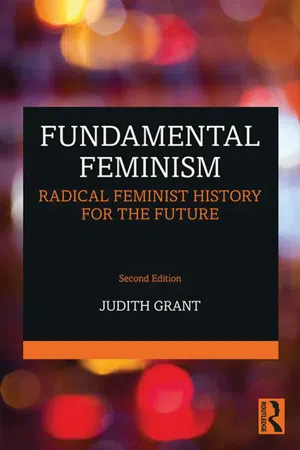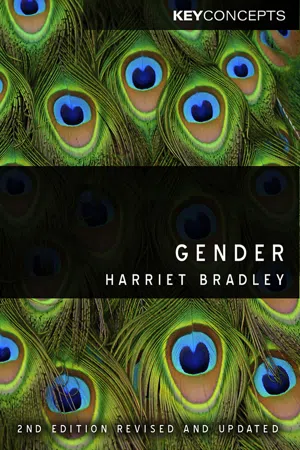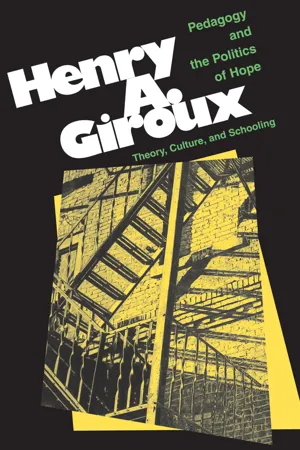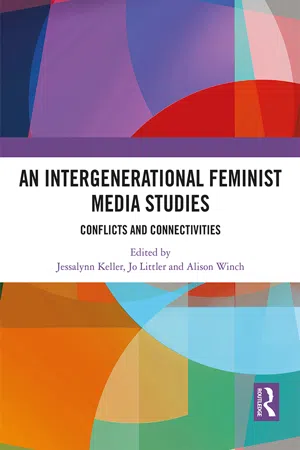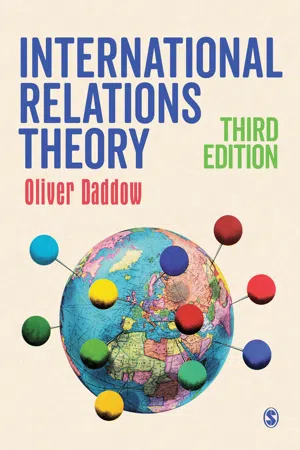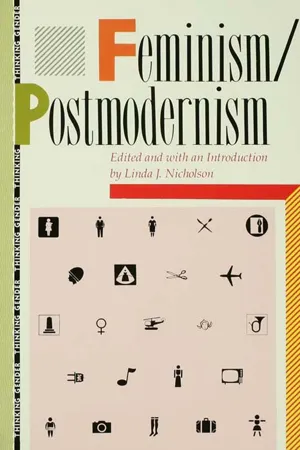Politics & International Relations
Postmodern Feminism
Postmodern feminism is a theoretical approach that challenges traditional feminist perspectives by emphasizing the intersectionality of gender with other social categories such as race, class, and sexuality. It critiques the idea of a universal female experience and seeks to deconstruct power dynamics and hierarchies. Postmodern feminists often advocate for diverse voices and perspectives within feminist discourse.
Written by Perlego with AI-assistance
Related key terms
Related key terms
1 of 4
Related key terms
1 of 3
10 Key excerpts on "Postmodern Feminism"
- eBook - ePub
- Roger D. Spegele(Author)
- 2014(Publication Date)
- Routledge(Publisher)
8 Postmodernist international relations feminist theory Can one avoid the maelstrom? DOI: 10.4324/9781315768007-81 Introduction
From the last chapter it should be apparent that modernist feminism has some formidable detractors who identify themselves as postmodernists and who have prepared the ground for replacing modernist feminism altogether by occupying the space between it and other feminist conceptions. Such a view is to be expected as soon as one grasps that Postmodern Feminism has a completely different epistemic view about the Subject (X in our formula) than the kind of feminism canvassed in the previous chapter. It also has different views of theory and practice and a different understanding of the role of philosophy and how to create radical change in the face of resistance.Postmodernist feminism is a conception which may be described as ‘discursive’ or a ‘discursive practice’, an idea that would lead us to expect women to take up different Subject positions in the performance of multiple subjectivities, that is, in perceiving themselves acting as mothers, food providers, citizens, community workers, artists, lesbians, intellectuals, the exact content being dependent on context and personal characteristics.To put this somewhat differently, for postmodern feminist international relations, identity is constructed through discourse and embodies interpretative possibilities that focus on inscriptions of styles and on performativity. Identity contains within it multiple, contested sights of meaning, encompassing critique and creativity. Postmodern feminist international relations’ conception of identity looks to the possibility of achieving emancipation via a radically different understanding of subjectivity: subjectivity is not discovered as in modernist conceptions; it is created. Such an understanding of subjectivity works within a shifting terrain of struggle in which the mode of identity is claimed, refused, reclaimed and (possibly) diffused. For postmodern feminist international relations there is no univocal entity woman - eBook - ePub
- Siegfried Schieder, Manuela Spindler, Siegfried Schieder, Manuela Spindler(Authors)
- 2014(Publication Date)
- Routledge(Publisher)
Feminist approaches of this kind advocate the view that the experiences of women must be the point of departure for feminist research. This is not just a matter of offsetting the androcentrism of existing theoretical approaches. Instead the expectation is that the feminine perspective on international politics will lead to different, potentially superior insights into the character of international relations. Implicit here is the concept of a “feminine morality” (see Nunner-Winkler 1991), though this entails the risk of absolutizing “typically” female characteristics and thus enshrining the hierarchical gender opposition found in established theoretical approaches in reverse. Here the superiority of feminine morality is justified sociologically and sometimes biologically and is primarily related to a supposed connection between motherhood and a peaceable nature. This essentialist line of argument, 7 which postmodern feminists criticize, is particularly palpable in radical feminism, which Sylvester regards as a political-practical variant of standpoint feminism (Sylvester 1994a: 49–52; see also Krell 1996: 155). Feminist postmodernism is characterized by a radical scepticism about the categories and intellectual structures of modern theoretical approaches, which include approaches such as feminist empiricism and standpoint feminism. The categories called into question from the perspective of feminist postmodernism include the subject that acts in a coherent and independent way and a neatly defined gender identity, along with the associated binary intellectual structures based on hierarchical oppositions. Feminist postmodernists lay bare the social constructedness of these modern categories and intellectual structures through deconstruction. As discussed earlier, it is the existence of a homogeneous category of “woman” that is being denied here. The emphasis is instead on the differences between women and the diversity of their experiences - eBook - ePub
Fundamental Feminism
Radical Feminist History for the Future
- Judith Grant(Author)
- 2020(Publication Date)
- Routledge(Publisher)
Spurs. Rather, in postmodern and Anglo-American feminist theory, analysis takes place from a political perspective; in short, through a feminist lens. Postmodern feminists look more to power and liberation vis-a-vis gender, and in this emphasis they depart from the tradition established around the core concepts. What is not always clear from post-modern feminisms, however, is what female liberation will look like. The images of nonidentity that are invoked as strategies for liberation are often alienating and not nearly so comforting as the peaceful community evoked in feminisms content to be grounded in a feminine principle. This does not change the fact that, in this instance, as with all other hyphenated feminist theories, a feminist politics guides the use of the theory. Though it is anti-foundationalist, Postmodern Feminism relies on a political identity that grew out of a foundation-alist feminism.Despite ambiguity about the very idea of postmodernism and its relationship to feminism, something called “Postmodern Feminism” is currently enjoying a lively existence among feminists off the Continent. These theorists do not shy away from calling themselves feminists, but do reject many of the major categories of Anglo-American feminism. Although they eschew an essentialized use of Woman, they do, in fact (even obviously), share the Anglo-American feminist desire for women’s liberation as a major raison d’etre. But rather than grounding feminism in female experience, gender is examined as a source of power and hierarchy, which are assumed to have a differentially negative impact on women as beings who embody the “feminine.” Power becomes a major category in this analysis. Epistemological questions about how to ground feminism in women’s experiences, and how to define Woman, become less important than questions about how to resist power and enhance freedom.This stress on power and freedom in some Postmodern Feminism is due in large part to the influence of Foucault. On the relationship between truth and power, he writes,[T]ruth isn’t outside power, or lacking in power…. Truth is a thing of this world: it is produced only by virtue of multiple forms of constraint. And it induces regular effects of power. Each society has its regime of truth, its “general politics” of truth: that is, the types of discourse which it accepts and makes function as true; the mechanisms and instances which enable one to distinguish true and false statements.8 - According to Waugh, this reflexivity has led feminists to discern a contradiction at the heart of their thinking: namely, that the quest for equality, which is the political heart of feminism, is based on the notion of a distinct and separate gendered identity. This in turn is the foundation of a common movement among women, the solidarity of sisterhood built on shared experience. But this idea of women as ‘different’ from men in some common way is similar, Waugh suggests, to the patriarchal ideology which legitimates different treatment of the sexes through the proposition of ‘essential’ and ‘natural’ gender difference. Like Mottier, we can question the idea that all women do share a common identity. Throughout the 1980s women from various ethnic minority backgrounds, in particular, argued that white feminism did not speak to or for them and that they did not feel included in the notion of ‘sisterhood’: their experiences, they stated, were too different from those of white middle-class women. This internal critique posed a radical challenge to how gender was conceived, moving from a primarily binary category (women/men) to a signifier of diverse and multiple identities.Ideas of ‘difference’ and ‘multiplicity’ are central issues in the postmodernist case against modernism. Before looking in more detail at the key features of a postmodern approach to gender, however, I want to discuss the political context which led to this shift in thinking.The politics of postmodernityIn the last chapter I linked the development of gender as an academic topic to the growth of the movement of radical protest in the 1960s. It is more difficult to make a firm link between Postmodern Feminism and particular political events, partly because, as we shall see, postmodernism is a very diffuse and diverse body of thought. However, I have no doubt that one key contextual influence was the break-up of the Soviet bloc, especially that major symbolic event, the fall of the Berlin Wall in 1989. The ‘deconstruction’ of the wall brought together two previously sundered social formations, one successfully capitalist, one (quasi?) socialist, into the new unified German Republic, breaching the frontline confrontation between these two combative ideological and political systems. This triumph of capitalism posed a major challenge to radical political thinking and appeared fatally to damage the legitimacy of Marxist theorizing. Many western Marxist intellectuals sought a new radical home. Along with this blow to Marxism, there evolved a general scepticism to the kind of ‘grand theories’ or ‘big ideas’ which the Marxist theory of socialist revolution perfectly exemplified. This is demonstrated in what is seen as the key initial text of postmodernity, Jean-François Lyotard’s The Postmodern Condition
- eBook - ePub
Pedagogy And The Politics Of Hope
Theory, Culture, And Schooling: A Critical Reader
- Henry Giroux(Author)
- 2018(Publication Date)
- Routledge(Publisher)
This often happens in a feminist context when race and/or class are not seen as factors determining the social construction of one’s gendered reality and most importantly, the extent to which one will suffer exploitation and domination. (32) In this case, the construction of gender must be seen in the context of the wider relations in which it is structured. At issue here is the need to deepen the postmodern notion of difference by radicalizing the notion of gender through a refusal to isolate it as a social category while simultaneously engaging in a politics that aims at transforming self, community, and society. Within this context, Postmodern Feminism offers the possibility of going beyond the language of domination, anger, and critique. Third, Postmodern Feminism attempts to understand the broader workings of power by examining how it functions through means other than specific technologies of control and mastery (de Lauretis, Technologies). At issue here is understanding how power is constituted productively De Lauretis develops this insight by arguing that while postmodernism provides a theoretical service in recognizing that power is “productive of knowledges, meanings, and values, it seems obvious enough that we have to make distinctions between the positive effects and the oppressive effects of such production” (“Feminist” 18). Her point is important because it suggests that power can work in the interests of a politics of possibility, that it can be used to rewrite the narratives of subordinate groups not merely in reaction to the forces of domination but in response to the construction of alternative visions and futures. The exclusive emphasis on power as oppressive always runs the risk of developing as its political equivalent a version of radical cynicism and antiutopianism - eBook - ePub
An Intergenerational Feminist Media Studies
Conflicts and connectivities
- Jessalynn Keller, Jo Littler, Alison Winch(Authors)
- 2019(Publication Date)
- Routledge(Publisher)
intersectional terms, and seems to be growing, rather than diminishing, in importance as part of a critical lexicon for understanding contemporary culture, with a number of writers noting its resilience and adaptability (Tisha Dejmanee 2016; Negra 2014).In addition to attempts to expand the term’s analytical reach with intersectional and transnational perspectives, it is also striking to see the dissemination of discussions of postfeminism across multiple sites and topics. Where earlier discussions focussed predominantly on media, the term now animates debates about work (Kelan 2009), education (Jessica Ringrose 2013), organizations (Patricia Lewis, Ruth Simpson, and Yvonne Benschop 2016), peer culture (Jessica Ringrose, Laura Harvey, Rosalind Gill, and Sonia Livingstone 2013; Alison Winch 2013), the cultural and creative industries (Scharff 2013), masculinities (Joel Gwynne and Nadine Muller 2013; Hannah Hamad 2014; Rachel O’Neill, 2015a), and the body and sexuality (Elias, Gill, and Scharff 2016; Angela McRobbie 2015). Far from receding or losing analytical relevance the notion seems to be gaining prominence as a way of engaging with some of the distinctive gendered features of contemporary neoliberal societies.Within feminist media studies the term is in prolific use today—deployed to analyse a multiplicity of media texts, but also to outline new ideological formations such as “postfeminist biologism” (Laura García-Favaro 2015), “austerity neoliberalism” (Sara De Benedictis 2016), or the novel contemporary representation of stay-at-home mothers (Shani Orgad and Sara De Benedictis 2015). It also remains central to debates about “quality television,” particularly in the US, which has evolved since the 1990s into a site of rich and complex representations of gender including Homeland, Veep, House of Cards, Orange is the New Black, Transparent, and The Good Wife - Kelly Oliver(Author)
- 2013(Publication Date)
- Routledge(Publisher)
19In my view, postmodernism's rejection of totalizing and universalizing models of and metanarratives about human (read male ) experience is especially useful for feminists. Passing beyond metanarratives of identity and of gender allows for embracing of difference and a proliferation of possible subject-positions and gender performances.20 As bell hooks argues, postmodern critiques of esscntialism, universalism, and “static over-determined identity” can be as useful for rethinking race as for rethinking gender.21 Postmodernists and many feminists are justly skeptical of metanarratives, which, as Madan Sarup notes, are “master narratives—narratives of mastery, of man seeking his telos in the conquest of nature.”22- eBook - ePub
- Barbara Fawcett(Author)
- 2018(Publication Date)
- Routledge(Publisher)
It is contended that in relation to maintaining the ability to critique and also to undertake political action, perspectives drawn from Postmodern Feminism(s) can be seen to have a contribution to make to the debates. However, before moving on to explore what is meant by Postmodern Feminism(s), it is useful to review feminist critiques of postmodern orientations and to consider the similarities and differences between feminism(s) and Postmodern Feminism(s).Feminist critiques of postmodern orientationsIt is argued in this book that orientations drawn from Postmodern Feminism(s) have relevance for current debates in the field of disability. However, within feminism(s), there are divergent views and these need to be attended to.Meaghan Morris (1988), although constructively critical of both Foucault and Lyotard, calls Foucault ‘a profoundly androcentric writer’ (Morris 1988: 55) and advocates that his writings are treated with caution within feminism(s). Jackson (1992) similarly asks why feminists would want to engage with postmodern authors the majority of whom are men who continue to promulgate a masculine theoretical tradition. Di Stefano (1990) in a similar vein asks whether ‘the uncertain promise of a political linkage between feminism(s) and postmodernism is worth the attendant political risks’ (Di Stefano 1990: 77). She highlights that these risks include wondering whether feminism(s) without a subject and some kind of standpoint can survive and the dangers in a pluralist world of becoming ‘an other among others’ (Di Stefano 1990: 77). She states: ‘It is as if postmodernism has returned us to the falsely innocent indifference of the very humanism to which it stands opposed; a rerun, in updated garb, of the modernist case of the incredible shrinking woman’ (Di Stefano 1990: 77).Alcoff (1988) contends that Foucault’s constitution of the modern subject erodes the agency of feminism(s) and also its credibility and legitimacy. She argues that Foucault’s perspective renders irrelevant both specific theoretical perspectives such as feminism(s) (and disability) and emancipatory movements, and destroys their normative base. Brodrib (1992) maintains that as it is only white men who have historically been recognised as subjects, it is somewhat suspect for this notion to be abolished just as white women and black people are also asserting their rights to be subjects. Deveaux (1994) warns against feminists uncritically utilising the ideas of Foucault and takes issue with the ways in which Foucault’s conceptualisation of the subject erases women’s specific experiences with power. She also highlights the inability of his approach to account for and articulate processes of empowerment (Deveaux 1994). Christian (1988) and Hartsock (1990) further question poststructuralist critiques of humanism and structuralism, particularly with regard to the relativistic implications for Third World and minority cultures in terms of their efforts to gain legitimacy for their struggles. - eBook - ePub
- Oliver Daddow(Author)
- 2017(Publication Date)
- SAGE Publications Ltd(Publisher)
Rwanda has made female participation in decision-making, and the life of the nation more widely, a firm political priority. Why has there been such a drive to inculcate gender equality so strongly in Rwandan politics? Juliana Kantengwa (2013) links it to the devastating genocide of the early 1990s, during which one million Rwandans lost their lives. The genocide ‘was the result of a divisive and destructive culture that had pervaded our society’. Kantengwa argues that inclusiveness and equality were at the heart of the national reconstruction process. In other words, liberal themes were uppermost in people’s minds as Rwanda rebuilt its internal politics and civic society. This process included: quotas on female representation in parliament (24 seats of the 80 are reserved for women, but voters consistently vote in many more than this); physical tasks for women in rebuilding the nation; peace-building in times of insurgence; and female involvement in truth and reconciliation, and justice and government programmes. Longer-term issues such as education and low levels of literacy among women compared to men were also addressed. Two decades later, writes Kantengwa, ‘gender roles had changed’.This is an excellent example of feminism in action, as well as a case study into the impact on gender roles of such things as a nation’s culture, history, politics and security environment. Changing hegemonic constructions of what it ‘means’ to be a woman in Rwanda has led to the emergence of a different type of politics: Rwanda has seen nothing less than a new construction of its gender politics.Poststructural feminism
This is the widest, most thoroughgoing feminist perspective that questions how we apprehend the world through language, our theories about the world, and our ‘scientific’ ways of studying IR. It works from the idea that ‘women have generally been outsiders, excluded from historical processes that have framed contemporary political and economic life, as well as from the development of knowledge that has interpreted those processes’ (Tickner 1996: 148). It concentrates on unpacking the latter exclusion by investigating the identities implicit in different gender constructions. We have seen above how gender divisions are constructed and play out around the interdependence of terms such as ‘masculine’ and ‘feminine’. These terms are hooked onto arrays of characteristics we associate with each gender. We further noted that these categories and characteristics are imbued with power relations in that masculine characteristics tend to be looked upon as the standard for the rest of humanity to live up to. Things masculine tend to be privileged over things feminine.Poststructural feminists use the ‘gender as power’ idea in two important ways:- They rethink the basis of the supposedly objective knowledge claims made by Western science. As Peterson points out (1992: 12–13), Western philosophy has tended to be the preserve of Western elite males, in which men’s experiences are said to be representative of all human experiences (i.e. they are universalized); supposed gender differences have been institutionalized in the academy and policy practice; and the Western phallocentric order privileges masculine qualities over feminine ones (for example, masculine ‘reason’ is elevated above feminine ‘passion’).
- eBook - ePub
- Linda Nicholson, Linda Nicholson(Authors)
- 2013(Publication Date)
- Routledge(Publisher)
Like all cultural formations, feminist gender-scepticism is complexly constructed out of diverse elements—intellectual, psychological, institutional, and sociological. Arising not from monolithic design but from an interplay of factors and forces, it is best understood not as a discrete, definable position which can be adopted or rejected, but as an emerging coherency which is being fed by a variety of currents, sometimes overlapping, sometimes quite distinct. In this chapter, I will critically examine four such currents and the (sometimes unintentional) routes by which they empty into the waters of gender-scepticism.The first current is the result of a recent academic marriage which has brought indigenous feminist concerns over the ethnocentrisms and unconscious racial biases of gender theory into a theoretical alliance with (a highly programmatic appropriation of) the more historicist, politically oriented wing of poststructuralist thought (e.g., Foucault, Lyotard). This union, I will argue, has contributed to the development of a new feminist “methodologism” which lays claims to an authoritative critical framework, legislating “correct” and “incorrect” approaches to theorizing identity, history, and culture. This methodologism, which eschews generalizations about gender a priori on theoretical grounds, is in danger of discrediting and disabling certain kinds of feminist cultural critique; it also often implicitly (and mistakenly) supposes that the adoption of a “correct” theoretical approach makes it possible to avoid ethnocentrism.The second current which I discuss in this chapter is the result of certain feminist appropriations of deconstructionism. Here, a postmodern recognition of interpretive multiplicity, of the indeterminacy and heterogeneity of cultural meaning and meaning-production, is viewed as calling for new narrative approaches, aimed at the adequate representation of textual “difference.” From this perspective, the template of gender iscriticized for its fixed, binary structuring of reality and is replaced with a narrative ideal of ceaseless textual play. But this ideal, I will argue, while arising out of a critique of modernist epistemological pretensions to adequately represent reality, remains animated by its own
Index pages curate the most relevant extracts from our library of academic textbooks. They’ve been created using an in-house natural language model (NLM), each adding context and meaning to key research topics.
Explore more topic indexes
Explore more topic indexes
1 of 6
Explore more topic indexes
1 of 4
